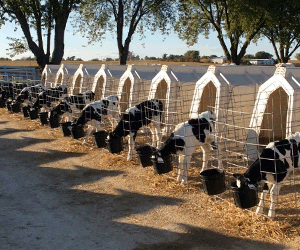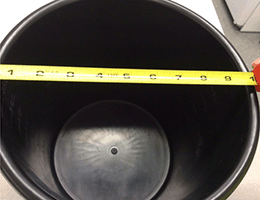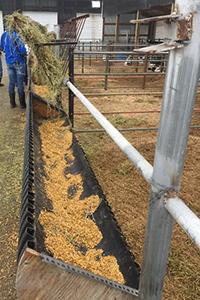
Fast Fact: What Is the Correct Angle for Bottle-feeding Calves? – Dr. Noah Litherland, Vita Plus
 By Dr. Noah Litherland, Vita Plus dairy youngstock technical specialist
By Dr. Noah Litherland, Vita Plus dairy youngstock technical specialist
Question: What is the correct angle for bottle-feeding calves?
Quick answer: The goal is to allow the calf to nurse comfortably with its nose below its eyes.
A bit more: How you feed is about as important as what you feed, or so the saying goes.
What you feed from is also important. Let’s take a quick look at feeding ergonomics from a calf’s perspective.
 Bottle holder
Bottle holder
The goal is to allow the calf to nurse comfortably with its nose below its eyes. The height of the nipple is the most important factor when evaluating bottle holder placement. When calves raise their nose above their eye level and stretch for feed, the epiglottis covering the opening of the trachea becomes out of position, allowing milk to potentially spill into the respiratory tract. The height of the feeding nipple in the image to the right is obviously placed too high, resulting in the calf stretching for feed.
Measure the distance from the bedding surface to the calf’s nose at a normal feeding position. This should be the height of the nipple in the bottle holder. Additionally, when training calves to drink, do not hold the bottle too high as this causes the same challenge as an excessively tall bottle holder.
Pail holder
Pail holders should be placed low enough to allow new calves to reach the bottom of the bucket without pinching or binding their necks. An excellent example of pail height is illustrated in the photo below.
 Pail holders are often placed too high for smaller calves, resulting in calves stretching for milk or kinking the bottom of their neck on the edge of the bucket. Adjustable bucket holders work well to allow for adjustments as the calf grows and as bedding depth increases over the nursery phase.
Pail holders are often placed too high for smaller calves, resulting in calves stretching for milk or kinking the bottom of their neck on the edge of the bucket. Adjustable bucket holders work well to allow for adjustments as the calf grows and as bedding depth increases over the nursery phase.
Pail holders should also allow buckets to sit level or slightly tipped toward the calf. Additionally, pail holders should have a divider or sufficient space between water and starter pails to prevent fowling of starter. Finally, pail holder design should prevent excessive calf starter shrink due to spilling or dumping pails. Placing pail holders outside of the calf hutch panels can decrease frequency of dunging in the pails, but can also increase shrink during rain and snow events.
 Pail size and shape
Pail size and shape
An ideal calf pail should have an 8-quart capacity to both hold a sufficient amount of milk, water and starter across all nursery ages, but also have enough width at the opening to allow the calf to easily get its head in the bucket to eat. An opening of at least 10 inches is recommended for calf feeding pails.
 Calves seem to eat grain most easily from a smooth and clean surface. Providing calves with a starter trough where the depth of grain is shallow and calves can lick from a clean surface might offer some advantage over a deep feeding vessel.
Calves seem to eat grain most easily from a smooth and clean surface. Providing calves with a starter trough where the depth of grain is shallow and calves can lick from a clean surface might offer some advantage over a deep feeding vessel.
| Category: |
Calf and heifer nutrition Equipment Starting Strong - Calf Care |

